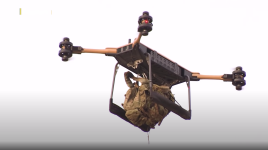- Reaction score
- 8,324
- Points
- 1,160
BAE has placed its bet. It has bought Malloy.
The Land Rover reference isn't totally specious. The targeted T-650 unit is supposed to lift 300 kg or roughly the payload of a Land Rover. It is also the typical payload of most Helicopter missions apparently.
 www.malloyaeronautics.com
www.malloyaeronautics.com
The Land Rover reference isn't totally specious. The targeted T-650 unit is supposed to lift 300 kg or roughly the payload of a Land Rover. It is also the typical payload of most Helicopter missions apparently.
BAE Systems is developing a new generation of heavy-lift military drones that can evacuate wounded troops and deliver supplies after snapping up a fast-growing British manufacturer.
The FTSE 100 defence giant on Thursday sealed a takeover of Malloy Aeronautics for an undisclosed sum, The Telegraph can reveal.
Berkshire-based Malloy is behind drones that the UK government has bought and supplied to Ukraine during the country’s war with Russia.
The takeover bolsters BAE’s presence in the rapidly growing market for unmanned aircraft, with the technology seen as having huge potential for both military and civil applications.
BAE is working with Malloy to develop the electric-powered T-650 drone, which can transport payloads of up to 300 kilograms – about the typical weight of a grand piano.
The T-650 will be able to have a range of attachments and different uses, including a “pod” that could eventually be used to safely transport wounded soldiers away from the front line of battle.
Malloy’s drones have been used in Ukraine to deliver supplies and may be used in future to deploy missiles.
Neil Appleton, a BAE executive who is now taking over as chief executive of Malloy, said the heavy-lift quadcopter drones had the potential to become “the Land Rover of the air” because of their versatility.
He said: “The cost per flying hour is much, much cheaper than a traditional helicopter, and you’ve not got the risk to life.
“So this type of product should become the workhorse of militaries globally. They can save their high value assets for the more complicated missions.”
The vast majority of helicopter missions currently move payloads of 300kg or less, according to BAE, meaning militaries can instead use drones.
The T-650 will have a range of 30 kilometres on one charge when at maximum capacity. Its rechargeable battery packs can be swapped out for fast redeployment.
It would also be far cheaper to operate than a helicopter. A $37m (£29m) US Navy Seahawk helicopter costs a reported $14,500 per hour to operate, for example, whereas the drones would cost vastly less.
Mr Appleton said the T-650 was likely to have a price tag of tens of thousands of pounds or “about the price of a mid-range car”.
Advertisement
Drones have been heavily used by Kyiv in the war with Russia. Their cheap cost and ease of deployment has been used to devastating effect against bigger and more expensive assets such as Russian tanks.
Malloy’s unmanned aircraft could also be used to deploy weapons such as missiles in future. One of the company’s drones was shown successfully deploying a Sting Ray torpedo during Nato training exercises last year.
Oriol Badia, chief operating officer of Malloy, said potential civilian applications for the technology included using them as air ambulances, carrying repair equipment to wind turbines and oil rigs, and a range of other logistical tasks currently undertaken using aircraft.
Malloy is headquartered in Maidenhead and manufactures its drones there. Mr Appleton said there were plans to expand the production lines as BAE seeks to sell the drones to a wider group of Nato countries.
Mr Badia added: “This new step in our journey with BAE Systems will allow us to combine the strengths and vision of a young company with the reach and support of an experienced one, ultimately giving our customers the ability to scale their demands and allow us to deliver innovative new products including the T-650 at pace.”
The 80-person business will become part of FalconWorks, the research and development arm of BAE’s air division.



